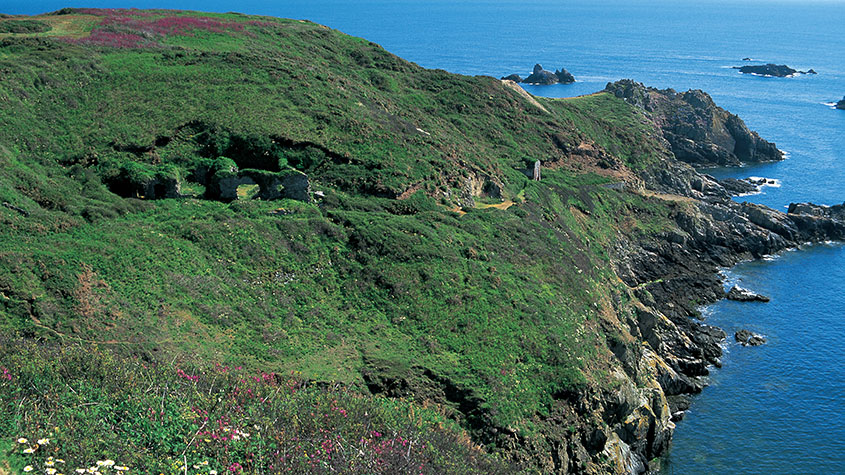A lesson for investors from a ill-fated silver mine
Mining methods may have changed since the industry’s early days, but the business hasn’t – digging ore from the ground and selling it at a profit. The trouble is, says Dominic Frisby, the scams haven't changed either.


While on holiday in Sark this week, I stumbled across a book in the local post office: “Silver Mining On Sark” by David Synnott, which describes an ill-fated mining operation on the island between 1836 and 1847.
“Plus ça change, plus c’est la même chose”, runs the old French saying. It applies to mining, it seems, as much as anything.
We don’t use canaries any more; mines are powered by diesel and electricity, instead of horse and manpower; helmets have torches instead of candles and there is underground lighting; and a higher premium is placed on human life than in the early 1800s, when workers were much more disposable.
Subscribe to MoneyWeek
Subscribe to MoneyWeek today and get your first six magazine issues absolutely FREE

Sign up to Money Morning
Don't miss the latest investment and personal finances news, market analysis, plus money-saving tips with our free twice-daily newsletter
Don't miss the latest investment and personal finances news, market analysis, plus money-saving tips with our free twice-daily newsletter
But the game is exactly the same: you’re trying to extract metal from rock and sell it at a higher price than you mine it for.
The scams are the same too.
How a silver mine brought the boom times to a tiny island
So let me tell you the story of Sark’s silver mine.
Sark, by the way, is a tiny island about two miles square, located between Guernsey and Jersey in the English Channel – much closer to France (25 miles) than England, which is over 200 miles away.
Remains show the island was inhabited in Neolithic times, but for many periods in the island’s history there was nobody here at all. Today it has around 500 residents. There are famously no cars on the islands – only tractors, horses, bikes and mobility scooters – and no street lights, giving you probably the best view of the night sky in Europe.
It’s famous for its harsh, windswept landscape with sheer cliffs and jagged rocks. It still has a feudal lord – who, by the way I beat at table tennis – and its own parliament.
In the early 1800s the language spoken here – the patois – was similar to Old Frankish. Very different from the Cornish spoken by the miners who would soon settle there.
If you take a boat trip round the island, there are visible copper salts leaching in the cliffs – which no doubt explains its appeal during the Bronze Age – and it was these visible salts that attracted prospectors to the island in the early part of the 19th century.
The Cornish at the time had one of the most evolved mining cultures in the world (also dating back to the Bronze Age), and they were operating mines as far afield as Argentina, North America (especially California, Wisconsin, Pennsylvania, Michigan and Virginia – in Chesapeake they even have a Cornish accent) and South Africa, where they operated the world’s largest copper mine at Okiep, 300 miles north of Cape Town.
Even the great Mark Twain – he of “a mine is a hole in the ground with a liar standing next to it” fame – was of Cornish descent.
In 1835, funded by an English mining adventurer called John Hunt – adventurer is a far better term than entrepreneur, is it not? – a team of Cornish miners arrived on the island in 1835 to mine the copper. They found lead and silver nearby, and began mining that too. And so was Sark’s Hope Mine built.
They should have called it the No Hope Mine – what was prospering in 1839 went badly wrong. How?
Profits erased by extravagant dinners and lax accounting
In the age old tradition of mining, management misled the shareholders. When the ore body was clearly not enough to support the mine, the mine captain deceived where possible to keep the game going. There was a long Cornish tradition of swindling “outadventurers” – investors basically – from London. Sometimes the mines worked, of course, and when they did everyone made a lot of money.
Management had a vested interest in keeping the Hope Mine going, even if it was no longer profitable. Some two hundred Cornish workers were employed by the mine, together with their wives (who may also have been employees – “bal maidens”, they were known as) and their families. Sark’s population soared to 790, the highest ever recorded.
As they chased ore, mine veins extended 800 yards and 300 feet out to sea where they were mining 20 fathoms – 120 feet – below sea level. You can imagine the noise in those tunnels when there’s a storm blowing overhead, waves crashing and all the rest of it. They actually had quite an ingenious device in play should the mine ever flood that would save the mine and some of its occupants.
General equipment could be brought in from Guernsey, but the speciality stuff had to be acquired from Cornish suppliers, with the effect that Guernsey and London shareholders were impoverished, while the “picks and shovels” players in Cornwall did just fine.
They would go on jollies to Guernsey for their legendary count house dinners, a tradition they had brought over from Cornwall – dinners which acquired legendary status for their extravagance – where news of the mine would be delivered to shareholders.
(The count house is the mine office, where the managers worked and where the miners were paid.)
Mining has a long and rich history of this. I remember the boom of the 00s and you would see management of non-producing exploration companies living it up at the Savoy, driving Ferraris to expensive lunches and dinners. Who’s paying for this?
The dinners would be buried in the company accounts. One outadventurer noted that he couldn’t see the spirits from a recent count house dinner in the accounts. The bursar, or what we might today call the CFO, declared that the spirits are there, you just can’t see them.
That’s not to say working mines was easy. Many lost their lives to it – 20% of Cornish miners were killed or incapacitated before they reached 40, so Cornwall became known as the county of widows. If you saw someone’s window open in Cornwall in winter, it’s likely that the occupier was a former miner gasping for air as his lungs were so damaged from breathing in the dust of thousands of gunpowder explosions.
As things went wrong in the early 1840s, the Seigneur of Sark – the feudal lord – borrowed money to try and keep the business going. But in 1847 the business finally collapsed. The Seigneur lost a lot more than his shirt. He died a year later, crushed with debt. His creditor, one Marie Collins, foreclosed on the debts and his son lost the fiefdom to her.
The son, Peter Carey, would become “a low life scamp”, to quote the (probably biased) archive of the Seigneurie. Sark got a new Seigneur and that same family retains the fiefdom to this day. The mine has never been reworked or re-explored and today it’s all grown over.
Irony of ironies, in Guernsey there is still a record of all the money paid out to shareholders, but those that recorded the company’s income have been lost.
Still, the episode had some long-term effects on the island
For a period there was an influx of capital. Prosperity then depression. It brought Methodism to the island, a school for girls and a doctor. It kick-started the tourist industry. The area around the mine – previously just heath – began to be farmed. The English language came to the island.
The houses that were built for the mine workers housed the Sarkese for many decades to come. Apparently because they weren’t built by the Cornish, but by the locals – so they were built with more longevity in mind
“In this spot,” said local historian Edgar Barnes, “centred anticipations never to be fulfilled, and hopes doomed to dire disappointment. At the bottom of the mine lie buried the fortunes of an ancient family, the hard earned savings of people who had little to spare, and the wasted energies of hundreds of stalwart men who had hoped to share in the wealth which their efforts were to have won. And now all has vanished, as if it had never been, save that there still remain – ghostly monuments of failure – the shafts and the chimneys and the ruins of the various offices.”
This is a story that has played out many times through the history of mining, and still plays out today. Investors – caveat emptor.
Get the latest financial news, insights and expert analysis from our award-winning MoneyWeek team, to help you understand what really matters when it comes to your finances.
Dominic Frisby (“mercurially witty” – the Spectator) is as far as we know the world’s only financial writer and comedian. He is the author of the popular newsletter the Flying Frisby and is MoneyWeek’s main commentator on gold, commodities, currencies and cryptocurrencies. He has also taken several of his shows to the Edinburgh Festival Fringe.
His books are Daylight Robbery - How Tax Changed our Past and Will Shape our Future; Bitcoin: the Future of Money? and Life After the State - Why We Don't Need Government.
Dominic was educated at St Paul's School, Manchester University and the Webber-Douglas Academy Of Dramatic Art. You can follow him on X @dominicfrisby
-
 Accelerating state pension age hikes could cost Brits in early 50s almost £18,000
Accelerating state pension age hikes could cost Brits in early 50s almost £18,000A recently launched review of the state pension age has sparked concern that the planned increases could be accelerated. How much could it cost you?
-
 How to invest by age - the one rule everyone can follow
How to invest by age - the one rule everyone can followWhether you’re a seasoned investor or new to the game, here’s the one investing rule to help determine how much you should invest according to your age
-
 Halifax: House price slump continues as prices slide for the sixth consecutive month
Halifax: House price slump continues as prices slide for the sixth consecutive monthUK house prices fell again in September as buyers returned, but the slowdown was not as fast as anticipated, latest Halifax data shows. Where are house prices falling the most?
-
 Rents hit a record high - but is the opportunity for buy-to-let investors still strong?
Rents hit a record high - but is the opportunity for buy-to-let investors still strong?UK rent prices have hit a record high with the average hitting over £1,200 a month says Rightmove. Are there still opportunities in buy-to-let?
-
 Pension savers turn to gold investments
Pension savers turn to gold investmentsInvestors are racing to buy gold to protect their pensions from a stock market correction and high inflation, experts say
-
 Where to find the best returns from student accommodation
Where to find the best returns from student accommodationStudent accommodation can be a lucrative investment if you know where to look.
-
 The world’s best bargain stocks
The world’s best bargain stocksSearching for bargain stocks with Alec Cutler of the Orbis Global Balanced Fund, who tells Andrew Van Sickle which sectors are being overlooked.
-
 Revealed: the cheapest cities to own a home in Britain
Revealed: the cheapest cities to own a home in BritainNew research reveals the cheapest cities to own a home, taking account of mortgage payments, utility bills and council tax
-
 UK recession: How to protect your portfolio
UK recession: How to protect your portfolioAs the UK recession is confirmed, we look at ways to protect your wealth.
-
 Buy-to-let returns fall 59% amid higher mortgage rates
Buy-to-let returns fall 59% amid higher mortgage ratesBuy-to-let returns are slumping as the cost of borrowing spirals.
